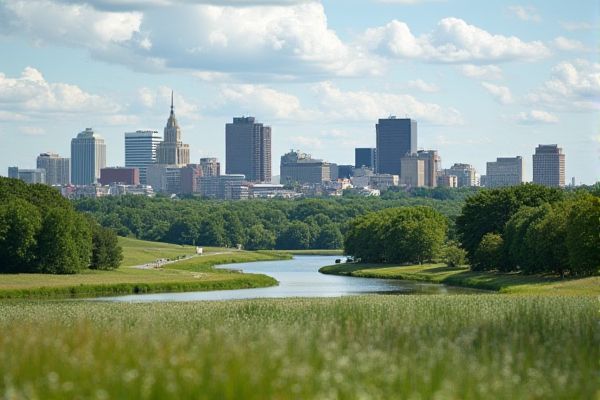
Utilities setup and providers in Nebraska: Major utility companies: NPPD, OPPD, Black Hills Energy. Set up services online or by phone. New resident deposit requirements. Nebraska Power Supply Opt-Out options. Choose from natural gas providers. Understand municipal utility systems. Utility billing structure and rates. Renewable energy programs availability. Low-income energy assistance programs. Emergency outage reporting procedures.
Major utility companies: NPPD, OPPD, Black Hills Energy.
In Nebraska, the major utility companies include Omaha Public Power District (OPPD), a publicly owned utility, serving over 855,000 people in Omaha and 13 surrounding counties. Other key players in the region are Nebraska Public Power District (NPPD), another public utility, and Black Hills Energy, a private company providing natural gas and electricity services. Black Hills Energy offers specific programs like the Nebraska HEAT rebates aimed at enhancing energy efficiency. To learn more about these services, visit the Omaha Public Power District page for detailed information.
Set up services online or by phone.
To set up utility services in Nebraska, you can register for an account online through providers like Nebraska Public Power District (NPPD), where you can view and pay your bill, set up automatic payments, and view your energy usage. For other services, such as electricity from Omaha Public Power District (OPPD) or natural gas from Black Hills Energy, you can also initiate setup online or by calling the respective customer service numbers.
New resident deposit requirements.
For new residents in Hastings, a minimum deposit of $200 is required for residential properties, although this can be waived if the customer sets up automatic bank account withdrawals. Commercial properties require a deposit determined upon application review. To learn more about the process and specific requirements, visit the official City of Hastings Utilities Service Connection page.
Nebraska Power Supply Opt-Out options.
Nebraska is uniquely served entirely by consumer-owned public power utilities, and there are no opt-out options for the public power supply system. Any changes or alternatives would be influenced by federal regulations such as the Federal Energy Policy Act. Despite such regulations, Public Power remains the dominant and preferred choice in the state.
Choose from natural gas providers.
The Nebraska Choice Gas Program, administered by Black Hills Energy, allows customers to select their natural gas commodity supplier from a list of participating providers, such as Constellation Energy, Black Hills Energy Services, and WoodRiver Energy. The selection period runs from April 4 to April 24, with the chosen supplier's pricing becoming effective on June 1 of that year.
Understand municipal utility systems.
In Nebraska, municipal utility systems are part of a broader public power structure, where 121 publicly-owned utilities, 10 cooperatives, and 30 public power districts provide electricity. These utilities are not-for-profit, operated locally, and governed by publicly elected boards or city councils, ensuring low electric rates, high reliability, and strong community involvement. For further insight into how these systems operate, visit the Public Power Structure website, which offers a deeper understanding of the mechanisms behind Nebraska's public power success.
Utility billing structure and rates.
In Nebraska, residential utility billing, particularly through Omaha Public Power District (OPPD), involves a structure with a monthly service charge and energy charges, including a variable energy charge and a fuel and purchased power adjustment (FPPA). Rates vary between the Standard Residential Service and the Residential Conservation Service, with different energy charges for summer and non-summer periods. For more detailed information, you can visit the Omaha Public Power District website.
Renewable energy programs availability.
Nebraska's renewable energy landscape is dominated by wind energy, which accounted for 92% of the state's total renewable-sourced net generation in 2023. The state also has hydroelectric, solar, biomass, and geothermal energy resources, with significant investments in new wind and solar projects, including public and private initiatives to expand renewable energy capacity and accessibility, particularly through programs supported by the Nebraska Department of Environment and Energy and federal funding. For more detailed insights, visit the U.S. Energy Information Administration website.
Low-income energy assistance programs.
In Nebraska, low-income households can access several energy assistance programs, including the Low Income Home Energy Assistance Program (LIHEAP), Pennies for Power, and utility-specific programs like the Metropolitan Utilities District (MUD) Home Fund and Omaha Public Power District's Energy Assistance Program. These initiatives offer financial assistance, energy efficiency improvements, and weatherization services to help alleviate utility costs. For more detailed information, visit the Utility Bill Assistance Resources for Nebraskans page, which provides a comprehensive overview of the available support options.
Emergency outage reporting procedures.
To report a power outage in Nebraska, customers can call 800-245-6977, report online, or check the Outage Map. In case of downed power lines or life-threatening emergencies, call 911 immediately.
